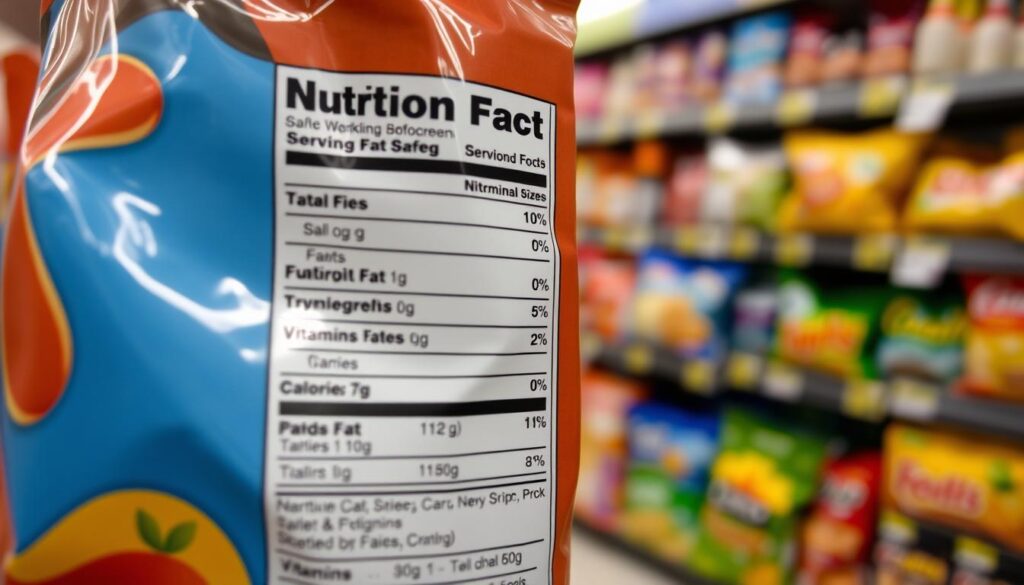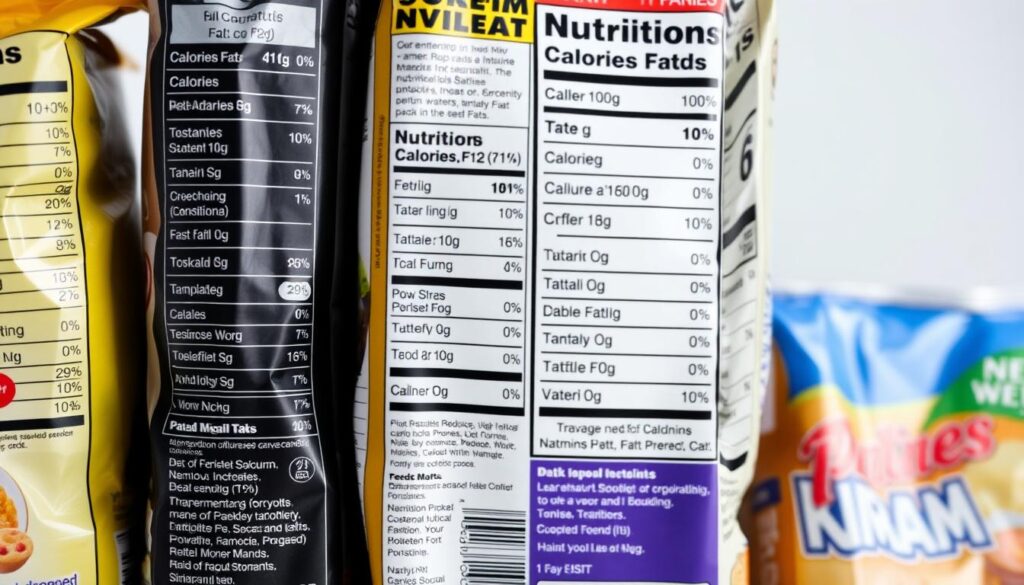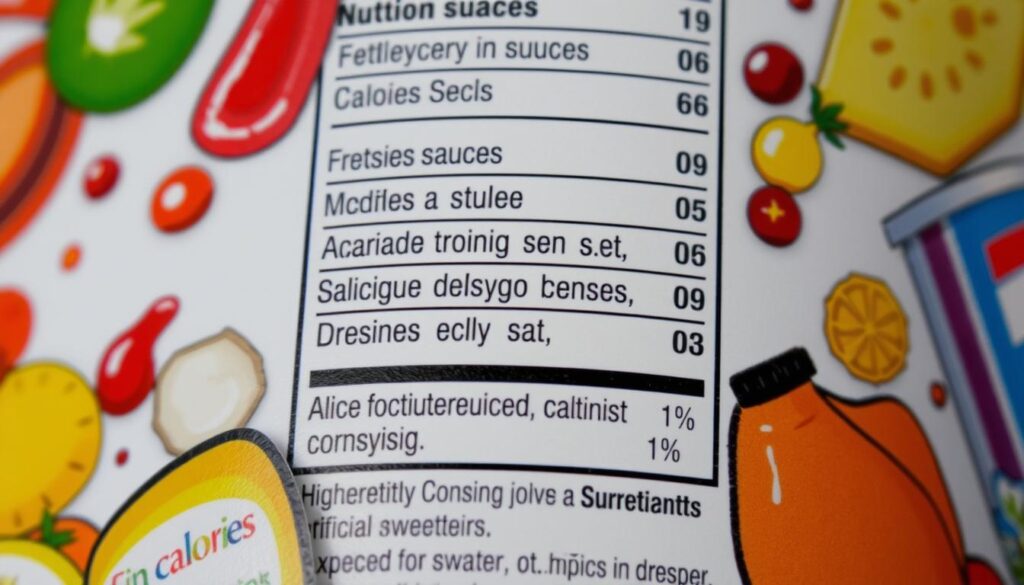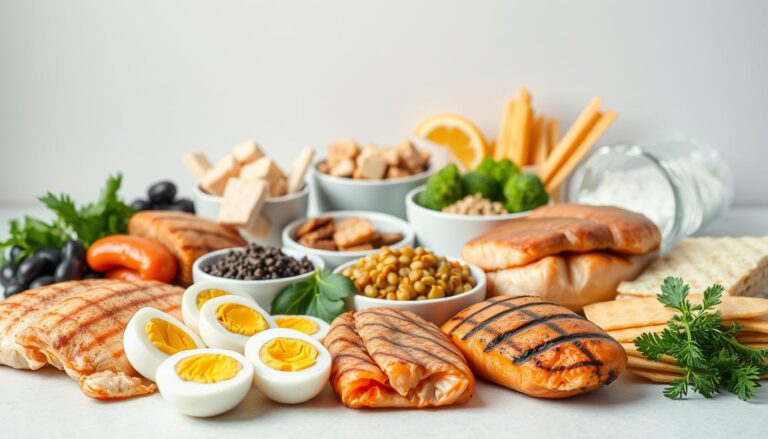Understanding nutrition labels might be the secret to losing weight. Most people need about 2,000 calories a day. Making smart food choices is key to a healthy lifestyle and losing weight. Labels help us know how food affects our health and can prevent chronic diseases.
Learning to read labels can lead to a healthier life and weight loss. High cholesterol affects nearly 40% of adults, raising heart disease risks. Knowing the daily cholesterol limit helps us make better diet choices. This knowledge is vital for a healthy lifestyle and successful weight loss.
Key Takeaways
- Understanding nutrition labels is crucial for a successful weight loss journey
- The average daily calorie intake considered adequate for most people is 2,000 calories
- Reading nutrition labels can help individuals make informed food choices, leading to better health outcomes and weight management
- A healthy lifestyle and weight loss are closely linked
- Nutrition labels provide essential information about the nutritional content of food products, including calories, fats, and sugars
- Healthcare professionals recommend selecting food products with high nutrient intakes (20% DV or greater) for fiber, vitamins, and minerals
- Nutrition experts suggest choosing food products with less than five ingredients for a wholesome and less processed diet
Understanding the Importance of Nutrition Labels in Your Weight Loss Journey
Learning to read nutrition labels is key for anyone trying to lose weight. By understanding nutrition facts, you can make choices that help you reach your health goals.
Why Nutrition Labels Matter
Nutrition labels give you important info about healthy food choices. They show the calorie count and what nutrients are in the food. This helps you pick foods that help you manage your weight.
For example, knowing that 40 calories is low and 400 calories is high helps you control your portions.
The Connection Between Label Reading and Weight Loss
Reading labels regularly makes you more aware of what you eat. Watching the % Daily Value (% DV) for nutrients like saturated fat and added sugars helps you avoid bad stuff. Foods with high % DV are rich in nutrients or calories, which is important to track.
Building Awareness Through Label Reading
Getting into the habit of reading labels makes you more mindful of your eating. It helps you choose foods with good nutrients like dietary fiber, vitamin D, and potassium. Also, avoiding foods with hidden sugars or too much sodium makes your diet healthier.

The Anatomy of a Nutrition Label
Understanding nutrition facts on food labels is key for nutritional balance and health. Each label gives detailed info based on a 2,000-calorie diet. But, your needs might be different.

The label starts with the serving size. This tells you how much nutrient you get per portion. Then, the calories section shows the energy from one serving.
Key nutrients include:
- Macronutrients: Proteins, fats, and carbohydrates
- Micronutrients: Vitamins and minerals like Vitamin D, Calcium, and Iron
- Daily Value Percentages: Shows how much a nutrient in one serving adds to your daily diet
For the best health, aim for:
- Added sugars under 25 grams for women and 36 grams for men
- Sodium less than 140 milligrams per serving for low-sodium choices
- At least 3 grams of fiber per serving in cereals, bread, and snacks
| Component | Amount per Serving | % Daily Value* |
|---|---|---|
| Calories | 200 | – |
| Total Fat | 8g | 10% |
| Sodium | 150mg | 7% |
| Total Carbohydrates | 30g | 10% |
| Protein | 5g | 10% |
| Vitamin D | 2mcg | 10% |
| Calcium | 260mg | 20% |
| Iron | 8mg | 45% |
| Potassium | 350mg | 8% |
*Percent Daily Values are based on a 2,000-calorie diet. Your daily values may be higher or lower depending on your calorie needs.
Decoding Serving Sizes and Portions for Weight Management
Knowing how much you eat is key to a balanced diet and losing weight. Eating too much can stop you from reaching your goals.
Understanding Serving Size Measurements
Nutrition labels show serving sizes based on a 2,000-calorie diet. Knowing these sizes helps you eat the right amount for you.
Calculating Your Personal Portion Needs
Your portion size depends on your weight loss goals, how active you are, and your diet. Calorie calculators can help find the right portion sizes for you.
Common Serving Size Mistakes to Avoid
- Assuming the entire package represents one serving.
- Overlooking multiple servings per container.
- Ignoring the calorie count of additional portions beyond the listed serving size.
Controlling your portions is crucial for losing weight. By reading labels and understanding serving sizes, you can make better choices for your diet and weight goals.
How to Read Nutrition Labels for Weight Loss Success: A Step-by-Step Guide
Understanding nutrition labels is key for those aiming to lose weight and live a healthy life. Follow these steps to make smart food choices.

- Check Serving Size: Start by looking at the serving size. All nutritional info is based on this amount.
- Calories Per Serving: Check the total calories to control your daily intake. Foods with 40 or fewer calories per serving are usually low-calorie.
- Calories from Fat: This shows how much fat adds to the total calories. Look for foods with minimal calories from fat.
- Sodium Content: Keep sodium under 1,500mg daily, as the Pritikin Program and health groups suggest.
- Types of Fat: Know the difference between saturated and unsaturated fats. Choose products with less than 20% of total calories from fat.
- Sugar Content: Limit added sugars to no more than 5% of your daily calories, about 2 tablespoons.
- Whole Grains: Make sure grains listed are whole grains. They offer essential fiber for a balanced diet.
Watch out for misleading claims like “99% fat-free,” which might still have high calorie content from fat. Always check the full nutrition label. By carefully examining each part, you can help your weight loss goals and live a healthy lifestyle.
Mastering Macronutrient Information
Understanding macronutrients is key to a balanced diet for weight loss. By learning about nutrition labels, you can make smart choices to reach your goals.
Proteins, Fats, and Carbohydrates
Proteins, fats, and carbohydrates are the main nutrients for your body. Proteins, found in foods like tofu, beans, and fish, are important for muscle health and controlling hunger. Fats, which give 9 calories per gram, should be 20-35% of your diet for balance. Carbohydrates, needed for energy, should be 45-65% of your calories, as the USDA suggests.
Calculating Daily Macro Needs
To figure out your daily macro needs, start with your Basal Metabolic Rate (BMR). For men, use this formula: BMR = 10 × weight (kg) + 6.25 × height (cm) – 5 × age + 5. For women, it’s BMR = 10 × weight (kg) + 6.25 × height (cm) – 5 × age – 161. Then, multiply your BMR by an activity factor from 1.2 (sedentary) to 1.9 (super active) to get your Total Daily Energy Expenditure (TDEE).
Balancing Macros for Weight Loss
For weight loss, a balanced macro approach is best. For example, a 2,000-calorie diet with a 30/40/30 ratio is good. This means 30% carbs, 40% protein, and 30% fats. This balance helps keep muscle while losing fat. Apps like MyFitnessPal can help track your macros to meet your nutritional goals.
| Goal | Carbohydrates (%) | Proteins (%) | Fats (%) |
|---|---|---|---|
| Fat Loss | 30% | 40% | 30% |
| Muscle Gain | 50% | 30% | 20% |
| Maintenance | 40% | 30% | 30% |
Hidden Sources of Calories and Sugar on Labels
When you’re trying to eat healthy, it’s key to spot hidden calories and sugars in foods. Many foods have sweeteners listed but don’t say “sugar.”
Look for names like corn syrup, rice syrup, and maple syrup. Also, molasses, honey, malted barley, and barley malt are hidden sugars. Terms like sorbitol or maltitol, and “ose” like dextrose or fructose, also mean added sugars.

Knowing about these hidden ingredients in nutrition facts labels helps avoid extra calories. This can help you lose weight. Here are some tips to spot and avoid these hidden sugars:
- Read the ingredient list for hidden sugar names.
- Choose products with fewer ingredients to avoid hidden sugars.
- Go for items with no added sugars and more fiber.
- Compare similar products and pick the one with fewer calories per serving.
Understanding these hidden sources helps you make better choices. This keeps your diet healthy and supports your overall well-being.
| Hidden Sugar Name | Common Source | Impact on Diet |
|---|---|---|
| Corn Syrup | Processed foods, beverages | High in calories, spikes blood sugar |
| Honey | Baked goods, cereals | Natural but still adds calories |
| Sorbitol | Diet foods, sugar-free products | Low-calorie sweetener, can cause digestive issues |
| Fructose | Fruit juices, sodas | High in calories, linked to weight gain |
| Maple Syrup | Pancakes, desserts | Natural but calorie-dense |
Using Nutrition Labels to Make Smart Food Choices
Nutrition labels are key to a healthy lifestyle. They help you make choices that boost your well-being.
Comparing Similar Products
When picking between similar healthy foods, labels are crucial. Look for:
- Calories: Pick lower calorie options to keep your weight in check.
- Added Sugars: Go for products with less added sugar to lower health risks.
- Fats: Choose items with healthier fats, like lower saturated fats.
Shopping Strategies Using Label Information
Make your shopping more efficient by reading labels:
- Plan Ahead: Create a shopping list to avoid buying on impulse.
- Check %DV: Look for products rich in nutrients like fiber and vitamins.
- Avoid Certain Ingredients: Steer clear of foods high in sodium or trans fats.
Building a Balanced Meal Plan
Use labels to create balanced meals for a healthy lifestyle:
- Balance Macronutrients: Make sure each meal has proteins, carbs, and fats.
- Incorporate Variety: Mix different healthy foods to meet all nutritional needs.
- Monitor Portions: Use serving sizes to control calories and keep your weight stable.
Common Nutrition Label Mistakes to Avoid
Understanding nutrition facts is key for a healthy diet. Yet, many people make errors that can block their weight loss goals.
Misinterpreting Percentages
Don’t get tricked by labels like “99% fat-free” soup or “2% fat” milk. These percentages talk about the product’s weight, not calories. For example, a 99% fat-free soup might still have 77% of its calories from fat. This can harm your health goals.
Overlooking Important Information
Details like serving sizes, total sugars, and hidden fats are often missed. Ignoring these can lead to eating more calories than planned. This can ruin your diet.
Label Reading Pitfalls
- Ignoring the serving size and eating multiple servings unknowingly.
- Focusing solely on calories while neglecting other nutrients.
- Overlooking the % Daily Value, which indicates nutrient proportions.
Conclusion: Empowering Your Weight Loss Journey Through Label Literacy
Understanding nutrition labels is key to your weight loss journey. By reading and interpreting these labels, you learn to make better choices. A study in the Journal of the Academy of Nutrition and Dietetics shows that those who read labels often have a lower BMI.
Misunderstanding serving sizes can lead to eating too much, even with healthy foods. Public Health England says knowing the right portion sizes is important for a healthy life. Dr. Emily Thomas points out that just 100 extra calories a day can add up to 5 kilograms a year.
By using label literacy, you can balance your nutrients and spot hidden calories and sugars. This helps you make informed choices and reach your weight loss goals. This skill not only helps you now but also supports a healthy lifestyle for the long term.
Every label has important information for better health. Make reading nutrition labels a daily habit. It will boost your confidence and clarity in your weight loss journey.





